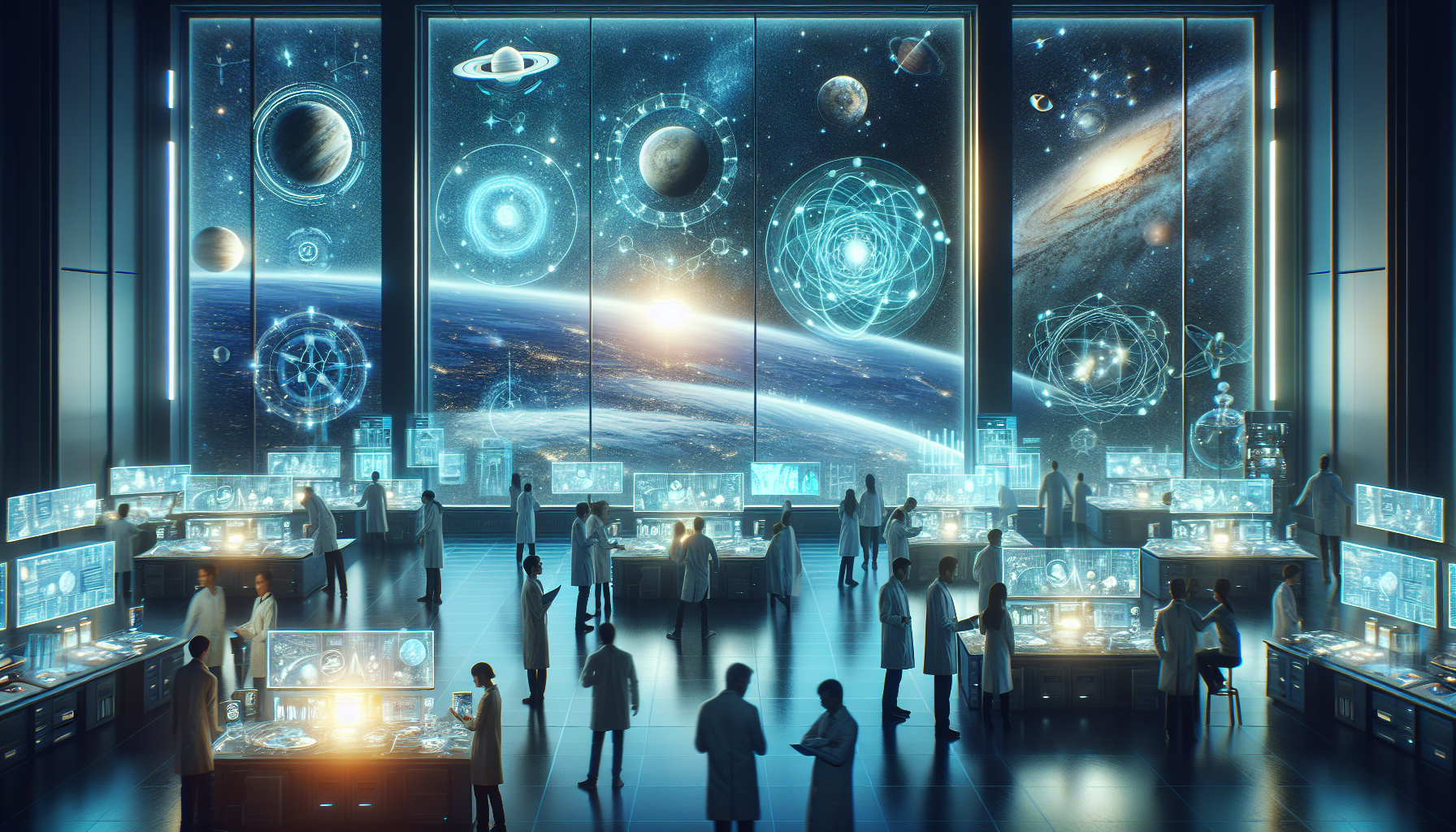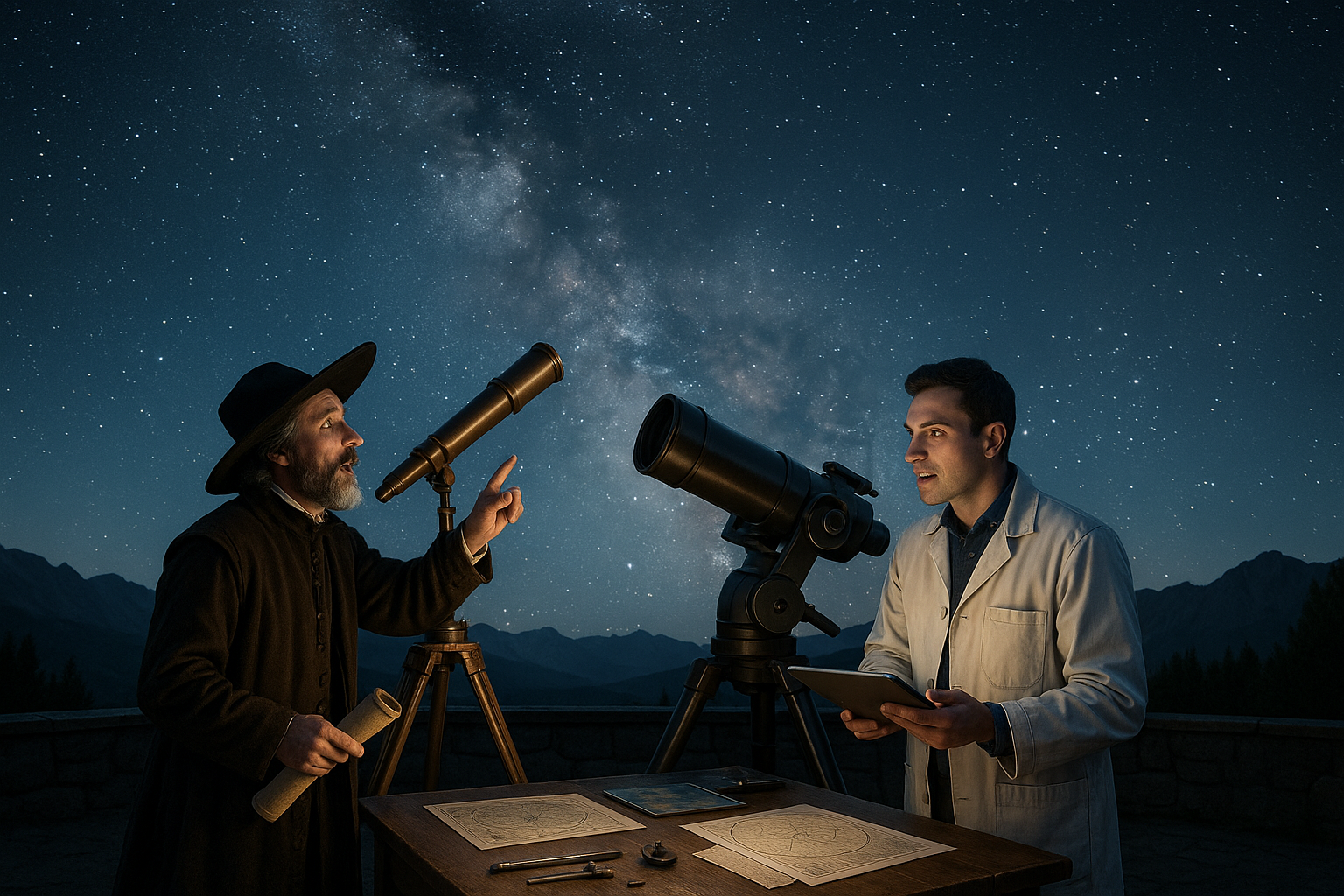In a universe that stretches far beyond the limits of our imagination, the mysteries of the cosmos have always fascinated humankind. From the earliest civilizations that gazed up at the stars, drawing constellations and crafting myths, to today’s cutting-edge explorations of distant galaxies, astronomy has continuously inspired us to look beyond our earthly confines. This innate curiosity to understand what lies beyond our world not only fuels our quest for knowledge but also drives technological advancements that have the potential to transform life on Earth. In this blog post, we delve into the realm of astronomy-inspired technologies and explore how these innovations are shaping a brighter future for all of us. 🚀
Imagine the precision required to send a spacecraft millions of kilometers away, navigating through the vastness of space with pinpoint accuracy. The technologies developed for space exploration demand an unparalleled level of innovation and ingenuity. These advancements, however, are not confined to the boundaries of space agencies or the depths of the cosmos. Instead, they often find their way into everyday life, revolutionizing the way we live, work, and interact with the world. From satellite technology that provides global communication and GPS services to materials science innovations that lead to stronger, lighter, and more efficient products, the influence of astronomy-inspired technologies is all around us.
One of the most profound impacts of space technology is on our understanding of climate change and environmental sustainability. Satellite imagery and remote sensing have become indispensable tools in monitoring the health of our planet, enabling us to track deforestation, glacial melting, and natural disasters in real-time. These insights are critical in shaping policies and strategies aimed at mitigating the effects of climate change and preserving our natural resources for future generations. Moreover, the development of renewable energy technologies, such as solar panels, owes much to the research conducted for powering spacecraft, demonstrating how the quest for interstellar travel can lead to sustainable solutions here on Earth. 🌍
In the realm of medicine, astronomy-inspired technologies are pushing the boundaries of what is possible. Techniques initially developed for capturing distant cosmic phenomena have been adapted to improve imaging technologies, enhancing the accuracy of medical diagnostics. Additionally, the microgravity environment of space has provided unique opportunities for biomedical research, leading to breakthroughs in understanding diseases and developing new treatments. From improving surgical precision to advancing personalized medicine, the intersection of space technology and healthcare is opening new frontiers in patient care and treatment outcomes.
In the realm of medicine, astronomy-inspired technologies are pushing the boundaries of what is possible. Techniques initially developed for capturing distant cosmic phenomena have been adapted to improve imaging technologies, enhancing the accuracy of medical diagnostics. Additionally, the microgravity environment of space has provided unique opportunities for biomedical research, leading to breakthroughs in understanding diseases and developing new treatments. From improving surgical precision to advancing personalized medicine, the intersection of space technology and healthcare is opening new frontiers in patient care and treatment outcomes.
The Intersection of Astronomy and Technology
Astronomy has always captivated the human imagination, leading to a deeper understanding of the universe and our place within it. But beyond the philosophical and scientific allure, astronomy has inspired a plethora of technologies that have profoundly shaped modern life. From navigation to telecommunications, the influence of astronomical studies extends far and wide. In this section, we will explore the intersection of astronomy and technology, delving into how celestial observations have spurred groundbreaking innovations.
One of the most significant contributions of astronomy to technology is the development of advanced imaging techniques. These methods, originally designed to capture distant stars and galaxies, have found applications in medical imaging. Technologies such as Magnetic Resonance Imaging (MRI) and Computed Tomography (CT) scans owe their precision and effectiveness to the principles of astronomical imaging. By harnessing the power of detailed imaging, healthcare professionals can diagnose and treat conditions with unprecedented accuracy, saving countless lives in the process.
Moreover, the quest to understand the cosmos has led to significant advancements in material science. The extreme conditions of space necessitate the creation of durable, lightweight materials that can withstand harsh environments. These materials, initially developed for space exploration, have trickled down to consumer products, enhancing everything from sports equipment to everyday electronics. The influence of astronomy on material innovation underscores the field’s far-reaching impact on technology and everyday life.
The Role of Satellites in Modern Communication
Satellites, a direct offshoot of astronomical research, play a pivotal role in modern communication. The idea of placing objects in orbit to facilitate global communication was born out of our understanding of celestial mechanics. Today, satellites are integral to the functioning of the internet, GPS, and broadcast media, ensuring that information can be transmitted across vast distances in real time. This capability has revolutionized how we connect, work, and access information, making the world a smaller, more interconnected place.
Furthermore, satellites are invaluable tools for monitoring climate change and environmental conditions. By providing comprehensive data on weather patterns, ocean currents, and land usage, satellites help scientists develop models to predict and mitigate the effects of global warming. This data is crucial for policymakers and researchers working to safeguard the planet’s future. The technological advancements spurred by astronomy thus have a direct impact on addressing some of the most pressing challenges of our time.
Another intriguing application of satellite technology is in the realm of disaster management. Satellites can provide real-time imagery and data during natural disasters, enabling first responders to assess damage and coordinate relief efforts more effectively. This capability highlights the critical role of astronomy-inspired technology in enhancing global safety and resilience. 🌍
Astronomy’s Influence on Artificial Intelligence
The realm of artificial intelligence (AI) has also been significantly shaped by astronomical research. The vast amounts of data generated by astronomical observations have necessitated the development of sophisticated algorithms to analyze and interpret these data sets. This has led to advancements in machine learning techniques, which are now being applied across various industries to automate processes and enhance decision-making.
AI technologies originally developed for astronomy are now being used to improve medical diagnostics, optimize supply chains, and even drive autonomous vehicles. By analyzing large data sets, AI systems can identify patterns and make predictions with a level of accuracy that was previously unattainable. This capability has the potential to transform industries, driving efficiency and innovation at an unprecedented scale.
Moreover, the collaborative nature of astronomical research has fostered advancements in data sharing and processing technologies. Large-scale astronomical projects often involve international teams working together to analyze vast quantities of data. This collaborative approach has led to the development of distributed computing platforms and data sharing protocols that are now being used to tackle complex problems in various fields, from climate science to genomics.
The Synergy of Astronomy and Machine Learning
Machine learning, a subset of AI, is particularly influenced by astronomical data analysis. The need to classify celestial objects and detect anomalies in vast data sets has spurred the creation of innovative machine learning algorithms. These algorithms are now applied in numerous sectors, from finance to retail, helping businesses anticipate trends and make data-driven decisions.
The synergy between astronomy and machine learning is also evident in the development of neural networks. These computational models, inspired by the human brain, are capable of recognizing patterns and learning from data. In astronomy, neural networks have been used to identify exoplanets and analyze cosmic microwave background radiation, among other applications. This technology is now being leveraged in voice recognition systems, recommendation engines, and other AI-driven solutions that enhance everyday life.
To see how these technologies are applied in the real world, check out this video: The Future of AI in Astronomy by Tech Innovations Channel. 🎥
Comparative Analysis of Astronomy-Inspired Technologies
To further understand the impact of astronomy-inspired technologies, it is helpful to compare their applications and benefits across different sectors. The table below highlights some key technologies and their diverse applications, demonstrating the wide-ranging influence of astronomical research.
| Technology | Astronomical Application | Non-Astronomical Application |
|---|---|---|
| Advanced Imaging | Capturing deep-space images | Medical imaging (MRI, CT scans) |
| Satellite Technology | Space exploration and observation | Global communication, GPS, disaster management |
| Machine Learning | Analyzing astronomical data | Autonomous vehicles, predictive analytics |
| Neural Networks | Identifying cosmic patterns | Voice recognition, recommendation systems |
As seen in the table, the technologies derived from astronomy have found applications in a wide array of fields, highlighting the interdisciplinary nature of scientific innovation. This cross-pollination of ideas and techniques enriches various industries, driving progress and enhancing quality of life across the globe.
Explore Further
- Check out the video above to learn more about the synergy between AI and astronomy.
- Explore the table for a comparative analysis of astronomy-inspired technologies.
- Consider how these innovations might shape the future of technology and science.
The ongoing exploration of the universe continues to inspire technological advancements that benefit society in countless ways. As we look to the stars, we are not only expanding our understanding of the cosmos but also unlocking new possibilities for innovation and progress on Earth. 🚀

Conclusion
In concluding our exploration of “Out of This World: Harnessing the Power of Astronomy-Inspired Technologies for a Brighter Future,” we find ourselves standing at the intersection of curiosity and innovation. This fascinating journey into the cosmos has illuminated how astronomical endeavors not only deepen our understanding of the universe but also drive technological advancements that profoundly impact our daily lives.
Throughout this article, we have delved into several key areas where astronomy-inspired technologies are making significant contributions. Firstly, we explored how satellite technology, originally developed for observing distant galaxies, is now instrumental in climate monitoring and environmental conservation. Satellites provide critical data that help us track climate change, manage natural resources, and respond to natural disasters more effectively. This transformation underscores the dual role of astronomy in both expanding human knowledge and safeguarding our planet.
Next, we examined the influence of astronomy on communication technologies. The principles of radio wave transmission and signal processing, refined through astronomical research, have paved the way for advancements in global communication networks. From satellite phones to high-speed internet, these technologies have shrunk our world, enabling instant connectivity across continents and fostering a more interconnected global community.
Our journey also took us to the realm of medicine, where imaging techniques such as MRI and CT scans, developed from astronomical imaging technology, are revolutionizing healthcare. By adapting methods used to capture images of distant celestial bodies, we have enhanced our ability to diagnose and treat a wide range of medical conditions, ultimately improving patient outcomes and quality of life.
Furthermore, we highlighted the burgeoning field of materials science, where the demands of space exploration have led to the creation of new materials with applications on Earth. The development of lightweight, durable materials used in spacecraft construction has translated into innovations in various industries, from automotive to consumer electronics, driving economic growth and sustainability.
Moreover, our discussion touched upon the role of astronomy in inspiring educational initiatives and fostering a culture of scientific inquiry. By igniting the imagination of future generations, astronomy encourages students to pursue careers in STEM (Science, Technology, Engineering, and Mathematics) fields, ensuring a continuous pipeline of talent ready to tackle the challenges of tomorrow.
The potential of astronomy-inspired technologies to address global challenges cannot be overstated. As we confront issues such as climate change, resource scarcity, and public health crises, these technologies offer promising solutions and pathways to a more sustainable and prosperous future. The fusion of cosmic curiosity with practical innovation exemplifies the best of human ingenuity and adaptability.
In reinforcing the importance of this theme, it is crucial to recognize that the benefits of astronomy extend beyond technological advancements. They touch upon the very essence of what it means to be human: our innate desire to explore, understand, and transcend boundaries. By looking to the stars, we gain perspective on our place in the universe and the interconnectedness of all life on Earth. This perspective is essential as we strive to create a future that is not only technologically advanced but also ethically and environmentally conscious.
As we conclude this discussion, I encourage you to reflect on the profound impact of astronomy on our world and consider how you might contribute to this exciting frontier. Whether through supporting educational initiatives, advocating for sustainable policies, or simply sharing this knowledge with others, each of us has a role to play in harnessing the power of the cosmos for the betterment of humanity.
Let this be an invitation to engage with the wonders of the universe and explore how they can be translated into tangible benefits for society. Comment below with your thoughts, share this article with your network, or apply these insights in your own endeavors. By working together, we can ensure that the innovations inspired by astronomy continue to propel us towards a brighter, more harmonious future.
Thank you for joining me on this cosmic journey. May the stars continue to inspire and guide us as we forge a path forward, ever mindful of the infinite possibilities that lie ahead. 🚀✨
*[For further reading on the applications of astronomy in technology, visit NASA’s Technology Transfer Program](https://technology.nasa.gov/). Also, explore the European Space Agency’s efforts in [sustainable development](https://www.esa.int/Applications/Observing_the_Earth/ESA_for_the_Green_Transition).]*
Toni Santos is a visual storyteller and cosmic interpreter whose work illuminates the ancient skywatchers and their prehistoric astronomy—the profound ways early humans observed and revered the heavens before written history. Through a visionary lens, Toni explores how the stars, planets, and celestial cycles shaped myth, ritual, and survival in cultures lost to time.
Rooted in a fascination with archaic observatories, stone alignments, and celestial symbolism, Toni’s creative journey reveals the deep human impulse to understand and harmonize with the cosmos. From lunar phases guiding planting seasons to the sacred paths of the Milky Way, each of his works embodies the awe and knowledge encoded in the night sky.
Combining artistic craftsmanship with archaeological insight, Toni’s pieces evoke the mystery and precision of prehistoric astronomers. His work does more than depict—it channels the timeless dance between earth and sky, bridging ancient wisdom with contemporary wonder.
As the visionary behind Vizovex, Toni shares curated visuals, essays, and symbolic studies that invite others to reconnect with the cosmic heritage written in stone and starlight. His creations are a call to look upward, to listen to the silent stories told by the stars, and to honor the first astronomers who mapped the heavens with reverence and ingenuity.
His work is a tribute to:
The celestial wisdom of prehistoric peoples
The sacred geometry of ancient observatories
The enduring bond between human culture and the cosmos
Whether you’re a stargazer, a scholar of ancient mysteries, or someone captivated by the universe’s earliest storytellers, Toni welcomes you to journey through a space where the sky is both map and myth—one constellation, one ritual, one revelation at a time.




